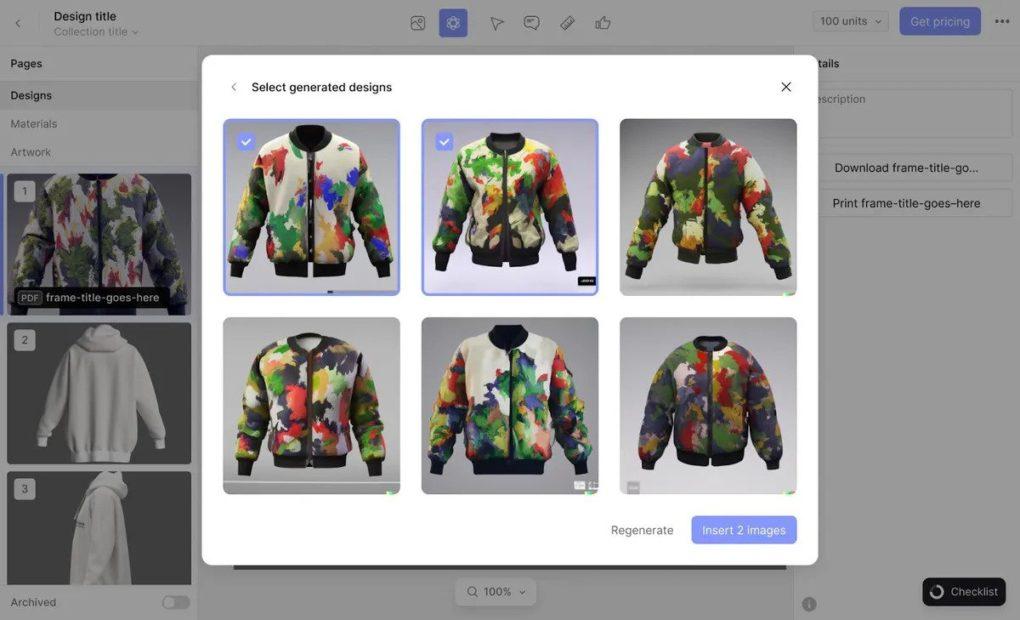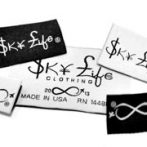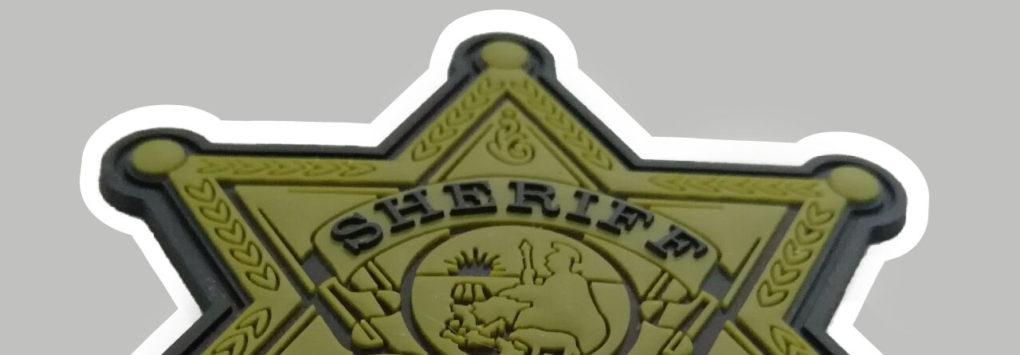AI is increasingly becoming a integral part of the fashion industry. Here are 10 ways AI is influencing clothing brands, from design to manufacturing to marketing. Keep reading and be up to date with the news about AI Generated Fashion!
- #1 Using Algorithms to Design Smart Clothes – AI Generated Fashion
- #2 Automating textile production with AI
- #3 Assisting Fashion Designers with AI
- #4 Designers are using AI to create custom-fit clothing
- #5 Using AI to develop new materials and fabric types
- #6 Retailers are using AI to personalize the shopping experience
- #7 In the near future some brands will use AI to create entire collections
- 8. Artificial intelligence application to predict fashion trends
- 9. Targeting ads based on user behavior
- 10. Automating retail tasks like stock management
- But not everyone is on board with this technology… yet
- Resources for AI Generated Fashion:
- Related Products
- Related Posts
#1 Using Algorithms to Design Smart Clothes – AI Generated Fashion
Designing clothes with algorithms is revolutionizing the fashion industry! IBM has taken the lead in this endeavor. In 2016 they used its artificial intelligence platform Watson to both inspire and provide technology for the Marchesa Cognitive Dress, presented at the Met Gala (a fundraising fashion event for the Metropolitan Museum of Art in New York City). The dress utilizes LED lights embedded in 150 flower embroideries that change color in real time according to emotion – a truly remarkable sight. What once seemed merely a fun concept is quickly becoming reality. We can’t wait to see what comes next!
#2 Automating textile production with AI
In 2001, a research done at the Hong Kong Polytechnic University by Wong, W. K. & Chan, C.K., conducted by investigators from the institute of Textiles and Clothing, presented a game-changing artificial intelligence method for planning the clothing manufacturing process. Through this paper (https://www.tandfonline.com/doi/abs/10.1080/00405000108659606) , it became evident just how effective this proposed algorithmic approach was for orchestrating an efficient design-to-manufacture workflow. The experimental results revealed that account management could be automated and parametric models could be developed to both manage orders more efficiently and create accurate simulations of the entire production line. Such innovative measures have since revolutionized the world of fashion clothing manufacturing.
#3 Assisting Fashion Designers with AI
A team of electrical and computer engineering experts from Aristotle University of Thessaloniki, Greece proposed in 2020 a revolutionary system for fashion product designers. Through their proposed artificial intelligence system, fashion product designers are empowered with a powerful personal assistant to find, sort and analyse clothing data from multiple sources. It provides personalised recommendations on products based on designer’s preferences.This groundbreaking innovation promises to be an essential tool for AI generated fashion design in the furure as they strive towards fulfilling their creative aspirations.

#4 Designers are using AI to create custom-fit clothing
Designers are increasingly turning to AI to create custom-fit clothing and bring their ideas to life. Hussain Almossawi, a designer and CGI artist based in New York City, uses AI at the brainstorming phase of design to help him find new ideas and inspirations, resulting in unique pieces such as his line of garments based on the Japanese kimono. Similarly, CALA, an “operating system for fashion” powered by OpenAI’s DALL-E API, enables designers to sketch, prototype, and produce new products quickly and accurately. Thus, AI is becoming increasingly pervasive in modern fashion design by allowing designers to easily customize clothing according to customer specifications.
#5 Using AI to develop new materials and fabric types
AI technology has revolutionized the way engineers develop new materials and fabric types. The Novel Materials Discovery (NOMAD) Laboratory has established since 2014 an impressive materials data infrastructure that offers AI tools and training to help engineer access a wide variety of resource via FAIR principles. With this technology in place, it is now easier than ever for engineers to create innovative new materials and fabrics with improved properties that better meet customer needs. This new development holds immense potential for any industry relying on engineered materials. The laboratory is part of the Fritz Haber Institute of the Max Planck Society and Humboldt University, located in Berlin, Germany.
#6 Retailers are using AI to personalize the shopping experience
The application of artificial intelligence and VR technology in clothing store display design has made remarkable progress in the fashion industry. According to a study (https://ieeexplore.ieee.org/abstract/document/9181520) conducted by HuiJuan Lai from the School of Fashion Engineering and SungWon Lee from the Department of Art & Design, this breakthrough centers around the development of an artificial intelligence module, an encryption system for control instructions and a follow-up system for generating simulation results in unfamiliar environments. The new techniques have opened up a world of opportunity when it comes to presenting clothing on virtual platforms or creating dynamic digital displays for real-life stores. This research offers great potential for the future, allowing fashion companies to reach customers more efficiently and effectively than ever before.
With the rapid growth of AI technology, retailers are turning to Artificial Intelligence for ways to personalize their customers’ shopping experiences. By assessing customer behavior, fashion trends and buying patterns, AI-driven tools can offer shoppers customized product recommendations and tailored discounts. Shopping can be made more convenient with tools such as AI-driven apps that help make recommendations or keep track of stock levels in physical stores. Furthermore, the use of AI in physical stores to identify shoppers’ preferences and suggest items they may like is expected to significantly improve the overall customer experience. It’s clear that retailers are embracing AI as an innovative way to better understand their customers and provide them with enhanced shopping experiences.

#7 In the near future some brands will use AI to create entire collections
As artificial intelligence (AI) continues to evolve in sophistication, the idea of AI-generated fashion is becoming a reality. For example, the German fashion platform Zalando and Google’s project Muze utilizes machine learning to create fashion designs by asking customers questions about their favorite textures, colors and style preferences. As a result, it created 40,424 fashion designs in its first month – an impressive feat for a technology still in its infancy. While some of these designs may look strange or unwearable, AI is growing ever closer towards fulfilling the vision of creating complete collections without human input. For now, however, we will have to rely on humans to provide the inspiring ideas that fuel the fashion industry.
8. Artificial intelligence application to predict fashion trends
In a research conducted by specialists at the Department of Fiber Science & Apparel Design, Cornell University, an A.I. algorithm proved to be a more efficient tool for understanding fashion dynamics compared to traditional methods. The model was trained using a large-scale dataset that covered different scenarios such as online stores and street snapshots. By analyzing the garment style and design details from runway photos and videos, the artificial intelligence could accurately detect clothing fabrics, textures and detailing – forming an understanding of overall fashion trends in the process. All of this makes this A.I.-based method a more accurate, sustainable, and cost-effective way to forecast upcoming designs than ever before.
9. Targeting ads based on user behavior
With AI-driven algorithms, ads can be tailored to the specific needs of users with incredible accuracy and precision. This ability to hyper-target ads based on a customer’s data allows companies to maximize their reach and optimize the effectiveness of their campaigns. As a result, ads generated using AI can be three times more likely to generate engagement than those without AI-powering them. For customers, it means that they are being provided with highly relevant content and are far more likely to purchase items after seeing an ad based on their past behaviors and preferences.
10. Automating retail tasks like stock management
AI-based inventory management tools provide extraordinary advantages that the retail industry can utilize with great success. According to a SkyMonk Consulting Engineers LLP, (India) study, AI not only provides notifications when stock needs to be re-ordered but is also used to create a detailed manufacturing schedule based on periodical variations in demand. As such, the autonomous and data driven supply chain has remedied issues such as logistics, warehousing and last mile delivery – something that e-commerce giants such as Amazon have definitely taken advantage of. The potential applications for automating retail tasks are numerous; it remains to be seen how the industry chooses to implement them further.
But not everyone is on board with this technology… yet
Automation and artificial intelligence, which enable machines and computers to perform tasks previously done by humans, are becoming increasingly popular in the business world as a way to increase efficiency, drive down costs, and streamline processes. But not everyone is on board with AI generated Fashion – at least not yet. Many industry experts believe that while automation may bring short-term benefits, it could potentially lead to long-term downsides such as job displacement, talent shortages, and reduced innovation. Companies need to thoroughly consider both pros and cons of using increased levels of automation before deciding whether or not to invest in it for their business operations.
As you can see, AI is changing the fashion industry in a number of ways – and it’s only going to become more prevalent in the years to come. Whether you’re a skeptic or an enthusiast, there’s no denying that AI is here to stay. So, what does that mean for you? Only time will tell. But one thing’s for sure: the future of fashion is looking very bright – and very automated.
Resources for AI Generated Fashion:
- Kato, N., Osone, H., Sato, D., Muramatsu, N., & Ochiai, Y. (2018, March). Deepwear: a case study of collaborative design between human and artificial intelligence. In Proceedings of the Twelfth International Conference on Tangible, Embedded, and Embodied Interaction (pp. 529-536).https://dl.acm.org/doi/abs/10.1145/3173225.3173302
- West, A., Clifford, J., & Atkinson, D. (2018). ” Alexa, build me a brand” An Investigation into the impact of Artificial Intelligence on Branding. The Business & Management Review, 9(3), 321-330.
- Liu, L., Zhang, H., Ji, Y., & Wu, Q. J. (2019). Toward AI fashion design: An Attribute-GAN model for clothing match. Neurocomputing, 341, 156-167
https://www.sciencedirect.com/science/article/pii/S0925231219303133
- Kotouza, M. T., Tsarouchis, S. F., Kyprianidis, A. C., Chrysopoulos, A. C., & Mitkas, P. A. (2020, June). Towards fashion recommendation: an AI system for clothing data retrieval and analysis. In IFIP International Conference on Artificial Intelligence Applications and Innovations (pp. 433-444). Springer, Cham.
https://cberuk.com/cdn/conference_proceedings/2019-07-14-10-24-19-AM.pdf
- Varsha, P. S., Akter, S., Kumar, A., Gochhait, S., & Patagundi, B. (2021). The impact of artificial intelligence on branding: a bibliometric analysis (1982-2019). Journal of Global Information Management (JGIM), 29(4), 221-246
https://www.diva-portal.org/smash/record.jsf?pid=diva2:1564476
- Shi, M., Chussid, C., Yang, P., Jia, M., Dyk Lewis, V., & Cao, W. (2021). The exploration of artificial intelligence application in fashion trend forecasting. Textile Research Journal, 91(19-20), 2357-2386





